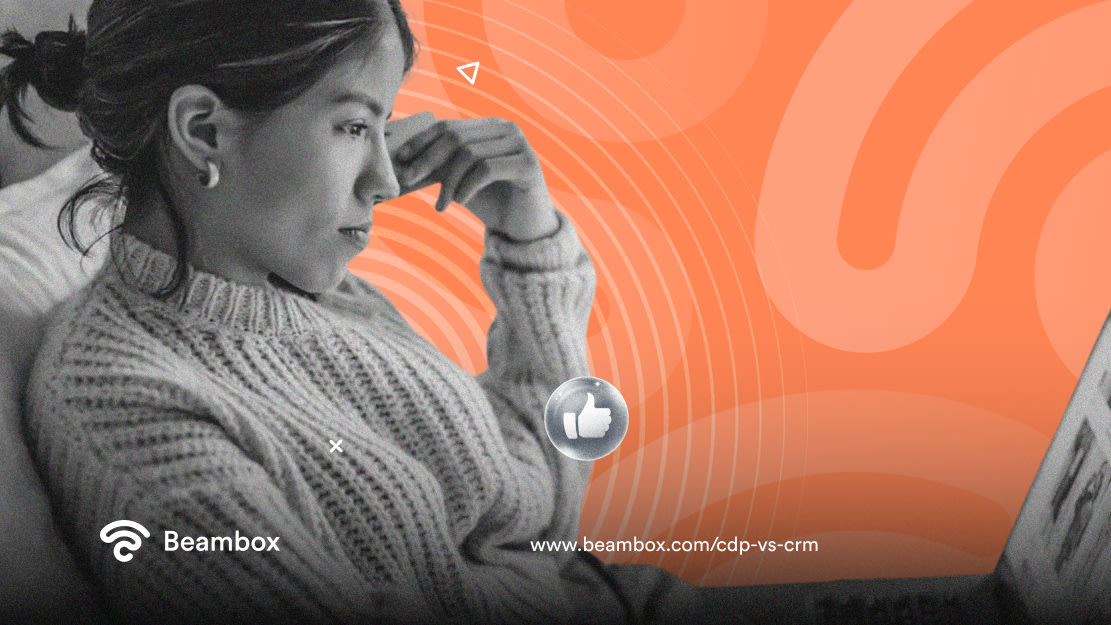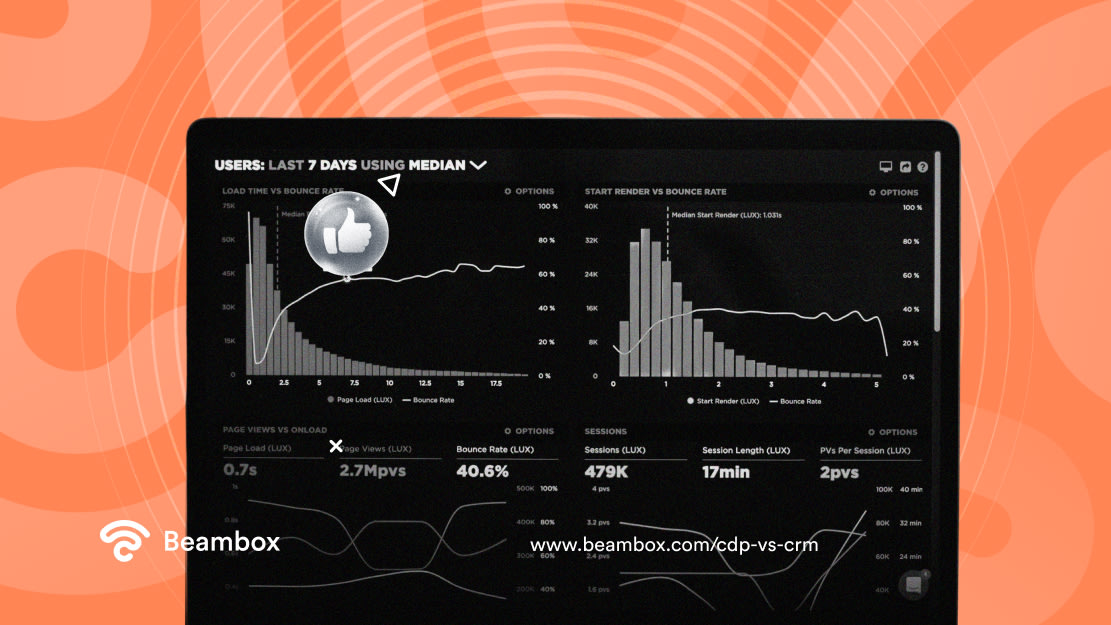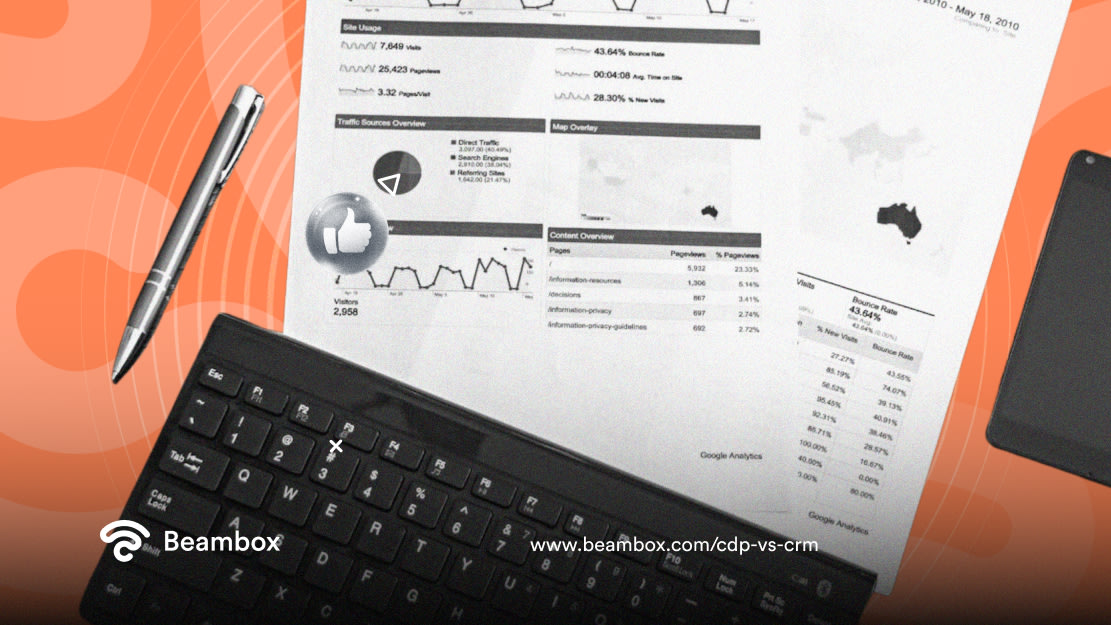CDP vs. CRM: Choosing Data Software That Fits Your Needs
There’s a reason why customer data is always trending in the corporate world: meeting their demands. Two popular tools for this are customer relationship management (CRM) systems and customer data platforms (CDP). Therefore, the need to understand CDP vs. CRM is natural.
People often confuse the two, thinking that both these tools collect first-party data about customers. But that’s where the similarities end. Besides, if you add a data management platform (DMP) into the mix, you’ve got a whole new comparison to tackle.
Identifying the differences between the three and choosing the best one for yourself can be difficult. But don’t worry—this article has everything you need, from individual definitions to comparisons and advantages. If you stick to the end, you’ll also learn when to choose which.

What Is a Customer Data Platform?
A customer data platform is software that unifies customer data from various sources into a centralized location. The result is a unified customer profile that you can use to shape personalized marketing strategies. But how does a CDP do that?
Well, it monitors customer behavior closely, monitoring everything they do to interact with your brand. For example, a customer might visit your website and browse some pages without making any purchase.
From the outlook, this seems like a failure. But if you rely on CDP for customer data collection, just a visit is enough to give you the upper hand.
To put this into context, let’s say you own an online clothing store. A person visits your website, browses the jacket section for a while, and then clicks off. After a couple of days, they see your ad on social media announcing a limited-time sale on jackets.
They immediately visited your website again and made a purchase. Now, the CDP will record and combine these actions for you to view. Similarly, it will create these profiles for all your customers, no matter how many touchpoints they visit.
How does that give you an upper hand? Because you have the customers’ buying patterns and preferences in addition to identifying data all in one location. Imagine what that will do for your future marketing campaigns.
What Is Customer Relationship Management Software?
Customer relationship management software is a tool that helps businesses manage all aspects of their customer interactions and relationships. It stores and organizes customer data from various sources, such as sales interactions, support tickets, and marketing campaigns.
You can also automate several sales tasks to focus on things that matter, i.e., healthy customer relationships.
Customers demand a streamlined experience with quick responses. This is only possible if you know the customer’s past with your business, such as purchases, communications, etc.
Now, this doesn’t mean a CRM doesn’t facilitate personalization. Thanks to CRM’s database, you can easily judge the preferences and expected behaviors of your customers. In that way, a CRM is similar to a CDP. But there are major differences, which we’ll get to in a second. For now, let’s explore the workings of a CRM with an example.
Let’s say a customer contacted you through your website before making the purchase. Once they place an order, they contact you on social media for updates. The CRM collects and combines these communications. A few days later, they get the package but claim it’s wrong.
If you don’t handle the situation properly, you might lose the customer forever. For that, you’ll have to go back in history to see things like what they ordered, how many, etc. That’s what a CRM helps you do.

Exploring the Difference Between CDP and CRM
As mentioned earlier, CRM and CDP have similarities but don’t perform the same tasks. From the data they collect to the way they use it, there are major differences that you can’t ignore.
But why is it important to know these details? Because their use depends on the situation. If you choose the wrong tool, even the most ideal situation might turn negative. So, before we think about which tool to use in what situation, let’s learn the difference between CDP and CRM.
1. CRM and CDP Collect Different Types of Data
The first difference between CRM and CDP lies in the types of data each tool collects. As you know, a CRM focuses on interactions with customers and your relationship with them. While it compiles this information from multiple sources, the data is within the bounds of customer-facing interactions.
This means it won’t show you things like website visits, clicks, social media likes, etc. However, it will gather things like reviews, chats, support requests, and actions where the customer interacts directly with your brand.
On the other hand, CDP collects a wider range of data. It combines all instances where the customer interacts directly and indirectly to create unified consumer profiles. This creates a more holistic view of customer behavior and preferences.
Moreover, a CRM usually only works with first-party data, which is basically customer information you collect yourself. Alternatively, a CDP might also pull information from zero, second, and third parties in addition to the first party.

2. CDP vs. CRM: Serve Different Objectives
After discussing the difference in data collection, let’s explore CDP vs. CRM in terms of the objectives they serve. These two aspects are actually related if you take a closer look. After all, different types of data serve different purposes, right?
When it comes to CRM, it says all in the name. The main objective of this tool is to help you manage customer relationships. It does so by letting you streamline customer interactions. It also has features that allow your staff in customer services to address and resolve issues quickly.
Moreover, customers demand immediate response. However, you can’t always be available, especially if your customer lives in another country. In this case, a CRM lets you automate conversations for the most frequent issues. Or, at the very least, you can automate the initial message to let the customer know you’ve got their message.
On the flip side, a CDP focuses on providing you with a holistic view of your customers. The main purpose here is to analyze the type of audience you have. Once you do that, you can segment them into groups and use the information for effective marketing.
3. How CRM vs.CDP Use Data Differently
Customer profiles are the last area in which these two tools differ. As mentioned earlier, a CDP creates a unified customer profile. This gives you a 360-degree view of customer behavior across all your touchpoints. You won’t have to monitor each platform separately because CDPs automatically bring the data together.
Similarly, CRMs also help you create customer profiles, which are detailed records of each client or lead. Unlike CDPs, these profiles are individual instead of unified.
The data these profiles contain might be purchase history, contact information, interaction logs, feedback, etc. As you can see, this data isn’t as broad as the information that a CDP stores.
Plus, a CDP gives you more insights into customer behavior and customer sentiment analysis than a CRM.
CRM vs. CDP vs. DMP: Exploring the Advantages of the Three
You might remember that we mentioned another tool, DMP, at the very beginning of this article. This is yet another tool that helps with data management, hence the comparison between CDP and CRM.
Now, one of the best ways to set one apart from the other is to explore the advantages of each. So, here’s what you need to know regarding CRM vs. CDP vs. DMP.
First, let’s talk about CDPs since you’re already familiar with them by now. The main advantage here is the collection of data from all touchpoints to provide a cohesive view of everything. Your marketing teams don’t have to make sense of data from individual tools to personalize their efforts. It’s all right there at their fingertips.
Apart from marketing, you can use this data to make improvements that reflect your customers’ preferences. By doing so, you’ll experience increased sales and revenue, customer satisfaction, and loyalty.
Moving onto CRMs, the main perk they offer is improved customer service. They help you strengthen customer relationships by making them feel heard. Again, an increase in sales and loyalty is a guarantee if you use a CRM correctly.
Moreover, a survey revealed that support teams without a CRM spent 15% of their time gathering customer data. But if you invest in this tool, you’ll be able to focus on other crucial tasks.
Besides, sales teams using a CRM can be more productive by automating routine communication tasks.
But enough about CDP and CRM, let’s move on to DMPs. Streamlined data is the first advantage. A DMP collects data from various sources, helping you create accurate customer segments. This comes in handy in lead generation. Plus, a CDP doesn’t always focus on second and third-party data, but a DMP gives you even more insights.

Choosing Between CDP vs.CRM
When exploring CDP vs.CRM, some people mistakenly declare one superior over the other. In reality, it isn’t a matter of which is better overall but rather which works better in a specific situation.
As you’ve already seen, both these tools fulfill different purposes. Therefore, depending on the situation, you must keep both in your pool and choose the right one.
When it comes to CRM, use it to nurture leads, view the sales journey, or identify bottlenecks. Other instances where a CRM works better than a CDP are communication, support tickets, and feedback.
Alternatively, use a CDP to provide customers with a personalized experience regardless of their channel.
Moreover, customer segmentation becomes easier and more accurate when using a CDP. So, choose a CDP to group customers based on their preferences, engagement levels, and behavior.
Combine All Data Tools To Make the Best Decisions
While CDPs focus on collecting and combining data from your brand touchpoints, CRM focuses on customer-facing interactions. The nature of customer profiles is also different in CDP vs. CRM. A CRM nurtures relationships, while a CDP provides a holistic view of your customer base.
With Beambox WiFi marketing, you can collect customer data and use them in your campaigns. Anytime users log into your WiFi and browse the internet, the system will collect data. The software then transforms vast amounts of data into simplified insights. You can use them to improve your communications and marketing results.
Getting customer data has never been this simple. Start your Beambox free trial now.
Get Started With Free WiFi Marketing
Beambox helps businesses like yours grow with data capture, marketing automation and reputation management.
Sign up for 30 days free


